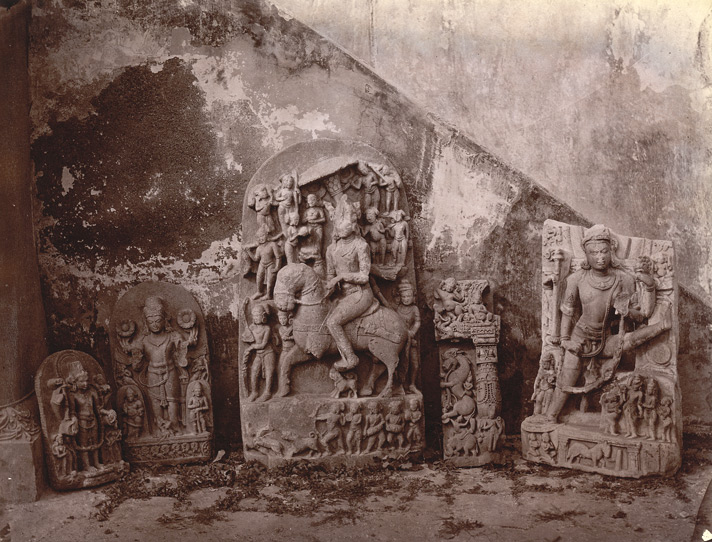This photograph of the Bihar museum was taken in the 1870s. Although it was credited to ‘Dr Simpson’, their is a strong possibility that it was taken by Joseph David Beglar. The photograph is part of the Archaeological Survey of India Collections and shows the museum buildings across a pool with a ghat positioned in front. A note by Bloch reads, “The sculptures photographed while exhibited in the Bihar Museum were collected from various places in Bihar, and are now in the Indian Museum. A paper by Mr Broadley, dealing with this collection, was published in Journal of the Asiatic Society of Bengal, vol. XLI, part I, 1872, pp. 209-311”.

Photograph of miscellaneous sculptures in the Bihar museum taken by Joseph David Beglar in the1870s, which forms part of the Archaeological Survey of India Collections. The accompanying report states that the sculptures are of “Aditya, Vishnu, Vamanavatara, Kalkiavatara, and fragments”. A note by Bloch reads, “The sculptures photographed while exhibited in the Bihar Museum were collected from various places in Bihar, and are now in the Indian Museum.” A paper by Mr Broadley, dealing with this collection, was published in Journal of the Asiatic Society of Bengal, vol. XLI, part I, 1872, pp. 209-311.

Photograph of the inscribed slabs in Bihar Museum taken in the 1870s and is part of the Archaeological Survey of India Collections: Indian Museum Series (volume 4: Bengal 161-210c). It was credited to ‘Dr Simpson’, but was possibly taken by Joseph David Beglar. The view shows a group of slabs, consisting of two Armenian tombstones, and five Islamic inscriptions. A note by Bloch reads, ‘The sculptures photographed while exhibited in the Bihar Museum were collected from various places in Bihar, and are now in the Indian Museum. A paper by Mr Broadley, dealing with this collection, was published in Journal of the Asiatic Society of Bengal, vol. XLI, part I, 1872, pp. 209-311.

This photograph of Vishnu riding Garuda in the Bihar museum was taken by Joseph David Beglar in the 1870s and is part of the Archaeological Survey of India Collections. A note by Bloch reads, “The sculptures photographed while exhibited in the Bihar Museum were collected from various places in Bihar, and are now in the Indian Museum. A paper by Mr Broadley, dealing with this collection, was published in Journal of the Asiatic Society of Bengal, vol. XLI, part I, 1872, pp. 209-311.” Garuda is the king of the birds and is one of the three principal animal deities in the Hindu pantheon alongside the elephant-headed Ganesha and the monkey god Hanuman. He is the charger of Vishnu and the two are often depicted together. Vishnu is also an important god in the Hindu pantheon as he is the preserver of the universe.

Photograph of some sculptures in the grounds of the Bihar museum taken by Sir Benjamin Simpson in the 1870s. The photograph is part of the Archaeological Survey of India Collections: Indian Museum Series. To the right is a highly ornamented sculpture pillar whilst behind it, set in niches are a number of sculptured slabs. A note written by Bloch concerning the Bihar museum states that, “The sculptures photographed while exhibited in the Bihar Museum were collected from various places in Bihar, and are now in the Indian Museum. A paper by Mr Broadley, dealing with this collection, was published in Journal of the Asiatic Society of Bengal, vol. XLI, part I, 1872, pp. 209-311.”

Photograph of some sculptures displayed in the entrance to the Bihar museum taken by Sir Benjamin Simpson in the 1870s. The photograph is part of the Archaeological Survey of India Collections: Indian Museum Series. The sculptures are identified as “pillars, dacavatara and navagraha slabs and Buddhistic statues.” A note written by Bloch concerning the Bihar museum states that, “The sculptures photographed while exhibited in the Bihar Museum were collected from various places in Bihar, and are now in the Indian Museum. A paper by Mr Broadley, dealing with this collection, was published in Journal of the Asiatic Society of Bengal, vol. XLI, part I, 1872, pp. 209-311.”

Photograph of some sculptures displayed in the grounds of the Bihar museum taken by Sir Benjamin Simpson in the 1870s. The photograph is part of the Archaeological Survey of India Collections: Indian Museum Series. The pieces are identified as “sculptured pillars, Buddhistic statues and statues of Vishnu.” A note written by Bloch states that, “The sculptures photographed while exhibited in the Bihar Museum were collected from various places in Bihar, and are now in the Indian Museum. A paper by Mr Broadley, dealing with this collection, was published in Journal of the Asiatic Society of Bengal, vol. XLI, part I, 1872, pp. 209-311.”

Photograph of a drawing of various sculptures from Bihar Sharif, in the Broadley Collection, taken by Sir Benjamin Simpson in the 1870s. This collection includes sculptures of ‘Aditya, Vishnu, Vamanavatara, Kalkiavatara, and fragments’ and are now in the Bihar museum. An abstract for A. M. Broadley’s paper: The Buddhistic Remains of Bihar in Patna in the Proceedings of the Asiatic Society of Bengal 1872, states, “The Bihar Sub-division presents perhaps the richest field for archaeological research in Eastern India. Within its comparatively small limits are situated Rajgir, Nalanda, Bihar, and the Indra-Saila peak, besides a hundred places of less importance, but abounding in the relics of the past. Over the whole surface of the country, neglected, and in many cases mutilated, lie the remains of sculptures, which once adorned the temples of Buddhism, still often bearing the inscriptions, which record the names of their donors and the date of their dedication…The whole of the sculptures collected have been removed to Bihar, and arranged in an appropriate building, which Mr. Broadley designates the ‘Bihar Museum’. They number upwards of a thousand and comprise every variety of object.” Broadley’s paper published in The Journal of the Asiatic Society of Bengal, vol. XLI, part I, 1872, pp.209-311, describes his travels and discoveries in the region in detail.

